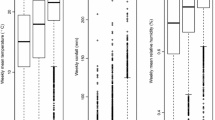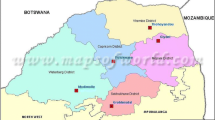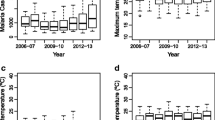Abstract
Malaria in Limpopo Province of South Africa is shifting and now observed in originally non-malaria districts, and it is unclear whether climate change drives this shift. This study examines the distribution of malaria at district level in the province, determines direction and strength of the linear relationship and causality between malaria with the meteorological variables (rainfall and temperature) and ascertains their short- and long-run variations. Spatio-temporal method, Correlation analysis and econometric methods are applied. Time series monthly meteorological data (1998–2007) were obtained from South Africa Weather Services, while clinical malaria data came from Malaria Control Centre in Tzaneen (Limpopo Province) and South African Department of Health. We find that malaria changes and pressures vary in different districts with a strong positive correlation between temperature with malaria, r = 0.5212, and a weak positive relationship for rainfall, r = 0.2810. Strong unidirectional causality runs from rainfall and temperature to malaria cases (and not vice versa): F (1, 117) = 3.89, ρ = 0.0232 and F (1, 117) = 20.08, P < 0.001 and between rainfall and temperature, a bi-directional causality exists: F (1, 117) = 19.80; F (1,117) = 17.14, P < 0.001, respectively, meaning that rainfall affects temperature and vice versa. Results show evidence of strong existence of a long-run relationship between climate variables and malaria, with temperature maintaining very high level of significance than rainfall. Temperature, therefore, is more important in influencing malaria transmission in Limpopo Province.




Similar content being viewed by others
References
Akinboade OA, Ziramba E, Kumo WL. (2008) The demand for gasoline in South Africa: An empirical analysis using co-integration techniques. Energy Economics 30: 3222–3229
Alemu A, Abebe G, Tsegaye W, Golassa Lemu (2011) Climatic variables and malaria transmission dynamics in Jimma town, South West Ethiopia. Parasites & Vectors 4:30
Atul K, Nettleman, M (2005) Global warming and infectious disease Archives of Medical Research 36: 689-696.
Baltas E (2007) Spatial distribution of climatic indices in northern Greece. Meteorological Applications 14: 69-78.
Blumberg L, Frean J (2007) Malaria control in South-Africa – challenges and successes. South African Med. Journal 97:1193-1197.
Bohle HG, Downing TE, Watts MJ (1994) Climate change and social vulnerability: Toward a sociology and geography of food insecurity. Global Environmental Change 4(1): 37–48.
Bouma MJ and van der Kaay HJ (1996) The El Niño/Southern Oscillation and the historic malaria epidemics on the Indian subcontinent and Sri Lanka: an early warning system for future epidemics? Trop. Med. Int. Health 1: 86–96.
Briet J, Vounatsou P, Gunawardena D, Galappaththy N, Amerasinghe P (2008) Temporal correlation between malaria and rainfall in Sri Lanka. Malaria Journal 7: 77.
Connor S, Thomson M, Molyneux D (1999) Forecasting and prevention of epidemic malaria: new perspectives on an old problem. Parassitologia 41: 439–448.
Craig MH, Kleinschmidt I, Nawn JB, Sueur DL, Sharp BL (2004) Exploring 30 years of malaria case data in KwaZulu-Natal, South Africa: Part I. The impact of climatic factors; Tropical Medicine and International Health Vol 9 (12) 1247–1257
Department of Science and Technology (DST) (2010) South African risk and vulnerability atlas. ISBN Number 978-0-620-45659-3
Dickey DA, Fuller WA (1981) Likelihood ratio statistics for autoregressive time series with a unit root. Econometrica 49: 1057–1072.
Duasa J (2007) Determinants of Malaysian trade balance: an ARDL Bound Testing approach. Journal of Economic cooperation, 28 (3), 21-40.
Ebi KL, Hartman J, Chan N, McConnell KJ, Schlesinger M, Weyant J (2005) Climate suitability for stable malaria transmission in Zimbabwe under different climate change scenarios. Climate Change 73: 375–393.
Epstein PR, Diaz HF, Elias SA, Grabherr G, Graham NE, Martens WJM, Mosley-Thompson E, Susskind J (1997) Biological and physical signs of climate change: focus on mosquito-borne diseases. Bulletin of the American Meteorological Society 78: 409-417.
Gerritsen AAM, Kruger P, van der Loeff MFS, Grobusch MP (2008) Malaria incidence in Limpopo Province, South Africa, 1998–2007. Malaria Journal 7:162. doi:10.1186/1475-2875-7-162
Githeko AK, Ndegwa W (2001) Predicting Malaria Epidemics in the Kenyan Highlands Using Climate Data: A Tool for Decision Makers. Global Change & Human Health 2 (1): 54-63. doi:10.1023/A:1011943131643
Granger, CJ (1969) Investigating Causal Relationships by Econometrics Models and Cross Spectral Methods. Econometrica. Vol. 37, pp. 425-435.
Greenidge K, Holder C, Mayers S (2009) Estimating the size of the informal economy in Barbados. Business, Finance and Emerging Economies 4(1)
Gupta R, Komen K (2009) Time aggregation and the contradictions with causal relationships: can economic theory come to the rescue? Studies in Economics and Econometrics. 33:13–24. ISSN: 03796205
Haines A, McMichael AJ, Epstein PR (2000) Environment and health: 2. Global climate change and health. Canadian Medical Association Journal 163(6):729
Hanafi-Bojd AA, Vatandoost H, Oshaghi MA, Charrahy Z, Haghdoost AA, Zamani G, Abedi F, Sedaghat MM, and Soltani M, Shahi M and, Raeisi A (2012) Spatial analysis and mapping of malaria risk in an endemic area, south of Iran: A GIS based decision making for planning of control. Acta Tropical 122(1): 132-137.
Haque U, Hashizume M, Glass GE, Dewan AM, Overgaard HJ, Yamamoto T (2010) The Role of Climate Variability in the Spread of Malaria in Bangladeshi Highlands. PLoS ONE 5(12): e14341. doi:10.1371/journal.pone.0014341
Harrus S, Baneth G (2005) Drivers for the emergence and reemergence of vector-borne protozoa land bacterial diseases. International Journal of Parasitology. 35(11–12):1309-1318.
Hashizume M, Terao T, Minakawa N (2009) The Indian Ocean Dipole and malaria risk in the highlands of western Kenya. Proc Natl Acad Sci USA 106: 1857–1862.
Hendry DF, Pagan A, Sargan JD (1984) Dynamic specification. In: Griliches, Z. Intrilligator, M. (Eds.), Handbook of Econometrics. vol. 2. North Holland, Amsterdam.
Huang F, Zhou S, Zhang S, Wang H, Tang L (2011) Temporal correlation analysis between malaria and meteorological factors in Motuo County, Tibet. Malaria Journal 10:54.. DOI:10.1186/1475-2875-10-54
Hulden L, Hulden L (2009) The decline of malaria in Finland—the impact of the vector and social variables Malaria Journal 8:94. DOI:10.1186/1475-2875-8-94
IOM. 2008. Vector-borne diseases: Understanding the environmental, human health and ecological connections. Washington, DC: The National Academies Press.
Jorgensen P, Nambanya S, Gopinath D, Hongvanthong B, Luangphengsouk K, Bell D, Phompida S and Phetsouvanh R (2010) High heterogeneity in Plasmodium falciparum risk illustrates the need for detailed mapping to guide resource allocation: a new malaria risk map of the Lao People’s Democratic Republic. Malaria Journal 9(1):59. DOI:10.1186/1475-2875-9-59.
Komen DK, Kapunda SM (2006) Macroeconomic determinants of poverty reduction in the era of globalisation in Kenya: Policy implications. African Journal of Economic Policy 13(2). ISSN 1116-4875
Kondo H, Seo N, Yasuda T, Hasizume M, Koido Y, Ninomiya N, Yamamoto Y (2002) Post-flood infectious diseases in Mozambique. Prehosp Disast Med. 17(3):126–133.
Kovats RS, Haines A (2005) Global climate change and health: recent findings and future steps. Canadian Medical Association Journal 172(4):501–502.
Kovats RS, Martens P (2000) Assessment of Potential Effects and Adaptations for Climate Change in Europe: The Europe ACACIA Project. Jackson Environment Institute, University of East Anglia, Norwich. 227-242
Kwiatkowski D, Phillips PCB, Schmidt P, Shin Y (1992) Testing the Null Hypothesis of Stationarity against the Alternative of a Unit Root. Journal of Econometrics 54: 159–178.
Lindblade KA, Walker ED, Onapa AW, and Katungu J, Wilson ML (1999) Highland malaria in Uganda: prospective analysis of an epidemic associated with El Nino. Trans. R. Soc. Trop. Med. Hyg. 93: 480–487.
Lindsay SW, Martens WJM (1998) Malaria in the African highlands: past, present and future. Bulletin of the World Health Organization, 76:33-45.
Lunde TM, Bayoh MN, and Lindtjørn B (2013)How malaria models relate temperature to malaria transmission Parasites & Vectors 6:20
Lunde TM, Korecha D, Loha E, Sorteberg A and Lindtjørn B (2013) A dynamic model of some malaria-transmitting anopheline mosquitoes of the Afrotropical region. I. Model description and sensitivity analysis. Malaria Journal 12:28
Mardia K, Kent J, Bibby J (1979) Multivariate analysis. Academic Press, London 518.
Messina JP, Taylor SM, Meshnick SR, Linke, AM, Tshefu AK, Atua B, Mwandagalirwa K, Emch M (2011) Population, behavioural and environmental drivers of malaria prevalence in the Democratic Republic of Congo. Malaria Journal 10(161):10. DOI:10.1186/1475-2875-10-161
Mordecai EA, Paaijmans KP, Johnson LR, Balzer C, Ben-Horin T, Moor E, McNally Amy, Pawar S, and Ryan SJ, Smith TC. 1 and Lafferty (2013) Optimal temperature for malaria transmission is dramatically lower than previously predicted. Ecology Letters, 16:22–30. doi:10.1111/ele.12015
Naqvi ZR (2009) Using remote sensing to assess potential impacts of hurricanes on mosquito habitat formation: Investigating the mechanisms for interrelationship between climate and the incidence of vector-borne diseases. Theses/Dissertations-Environmental Studies. Submitted to the Graduate Faculty of Baylor University
Narayan PK (2004) Reformulating critical values for the bounds F-statistics approach to cointegration: an application to the tourism demand model for Fiji. Department of Economics 2004 Discussion Papers no. 02/04. Monash University, Melbourne, Australia
Ngomane L, de Jager C (2012) Changes in malaria morbidity and mortality in Mpumalanga Province, South Africa (2001–2009): A retrospective study. Malaria Journal 11:19
Nkomo JC, Nyong AO, Kulindwa, K (2006) The impacts of climate change on Africa. Final Draft Submitted to: The Stern review on the economics of climate change
Paaijmans KP, Blanford S, Bell AS, Blanford JI, Read AF. Thomas MB (2010) Influence of climate on malaria transmission depends on daily temperature variation. PNAS 107 (34): 15135–15139
Panofsky HA, Brier GW (1968) Some applications of statistics to Meteorology. The Pennsylvania State University, University Park, Pennsylvania 224
Pascual M, Ahumada JA, Chaves LF, Rodo´ X, Bouma M (2006) Malaria resurgence in the East African highlands: Temperature trends revisited. Proceedings of the National Academy of Sciences USA 103:5829–5834
Patz JA, Campbell-Lendrum D, Holloway T, Foley JA (2005) Impact of regional climate change on human health. Nature 438, 310-317. DOI:10.1038/nature04188
Patz JA, Hulme M, Rosenzweig C, Mitchell TD, Goldberg RA, Githeko AK, Lele S, McMichael AJ, Le Sueur D (2002) Climate change: regional warming and malaria resurgence. Nature 420:627-628
Patz JA, Olson SH (2006) Malaria risk and temperature: Influences from global climate change and local land use practices. Ann Trop Med Parasitol. 100(5-6):535-49.
Pesaran MH, Shin Y (1999) An autoregressive distributed lag modelling approach to cointegration analysis. In: Strøm S, editor. Econometrics and economic theory in the twentieth century: the Ragnar Frisch Centennial Symposium.Cambridge: Cambridge University Press.
Pesaran MH, Shin Y, Smith RJ (2001) Bounds testing approaches to the analysis of level relationships. Journal of Applied Econometrics 16: 289-326
Poveda G, Rojas W, Quinones ML, Velez ID, Mantilla RI, Ruiz D, Zuuaga JS, Rua GL (2001). Coupling between annual and ENSO timescales in the malaria-climate association in Colombia. Environ. Health Perspect. 109:489–493.
Reiter P (2008) Global warming and malaria: knowing the horse before hitching the cart. Malaria Journal 7 (Suppl 1):S3. doi:10.1186/1475-2875-7-S1-S3
Relman DA, Hamburg MA, Choffnes ER, Mack A (2008) Global climate change and extreme weather events: understanding the contributions to infectious disease emergence: workshop summary. ISBN: 0-309-12403-4, 304pp, 6 × 9
Rogers DJ, Randolph SE (2000) The global spread of malaria in a future, warmer world. Science, 289:1763–1766.
Sharp BL, Ngxongo S, Botha MJ, Ridl FC, Le Sueur D (1998) An analysis of 10 years of retrospective malaria data from the KwaZulu areas of Natal. South African Journal of Science 84,102–106.
Shewmake S (2008) Vulnerability and the impact of climate change in South Africa’s Limpopo River Basin. IFPRI Discussion Paper 00804
Siraj AS, Santos-Vega M, Bouma MJ, Yadeta D, Carrascal DR, Pascual M (2014) Altitudinal Changes in Malaria Incidence in Highlands of Ethiopia and Colombia Science 343(6175):1154-1158. DOI:10.1126/science.1244325
Sultan R (2010) Short-run and long-run elasticities of gasoline demand in Mauritius: an ARDL bounds test approach. Journal of Emerging Trends in Economics and Management Sciences 1 (2): 90-95
Thomson MC, Mason SJ, Phindela T, Connor SJ (2005) Use of Rainfall and Sea Surface Temperature Monitoring for Malaria Early Warning in Botswana: Am. J. Trop. Med. Hyg. 73(1): 214–221
Tshiala MF, Olwoch JM, Engelbrecht FA (2011) Analysis of temperature trends over Limpopo province, South Africa. Journal of Geography and Geology. 3(1):13
van Lieshout M, Kovats RS, Livermore MTJ, Martens P (2004) Climate change and malaria: Analysis of the SRES climate and socio-economic scenarios. Global Environmental Change 14(1): 87-99
Wilks, DS (1995) Statistical methods in the atmospheric sciences. International Geophysics Series. 59: 469.
Williams HA, Roberts J, Kachur SP, et al. (1999) Malaria surveillance—United States, 1995. Morbidity and Mortality Weekly Report. vol. 48, no. 1, pp. 1–23.
Zhou G, Minakawa N, Andrew K, Guiyun Y (2004) Association between climate variability and malaria epidemics in the east African highlands. Proc Natl Acad Sci USA 101: 2375–2380.
Zucker JR (1996) Changing patterns of autochthonous malaria transmission in the United States: a review of recent outbreaks. Emerging Infectious Diseases. vol. 2, no. 1, pp. 37–43.
Acknowledgments
This study was funded by the EU project QWeCI (Quantifying Weather and Climate Impacts on health in developing countries; funded by the European Commission’s Seventh Framework Research Programme under the Grant agreement 243964).
Author information
Authors and Affiliations
Corresponding author
Rights and permissions
About this article
Cite this article
Komen, K., Olwoch, J., Rautenbach, H. et al. Long-Run Relative Importance of Temperature as the Main Driver to Malaria Transmission in Limpopo Province, South Africa: A Simple Econometric Approach. EcoHealth 12, 131–143 (2015). https://doi.org/10.1007/s10393-014-0992-1
Received:
Revised:
Accepted:
Published:
Issue Date:
DOI: https://doi.org/10.1007/s10393-014-0992-1




